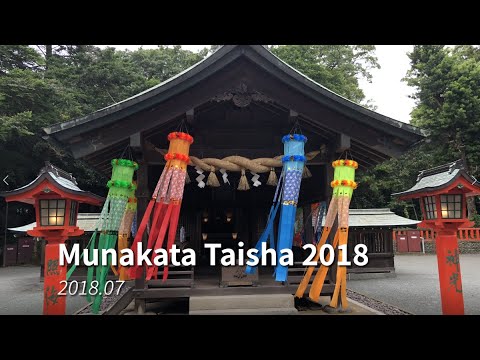[ Maniac Japan Travel -Kyushu ]
Munakata (宗像) is a city in Fukuoka Prefecture and home to the three Munakata Shrines (Munakata Taisha), the head shrines of several thousand Munakata shrines found across Japan. The original shrine stands on the remote, sacred island of Okinoshima which is off-
limit to the public. Lying along the sea route to Korea, the island has served as a place to pray for safe travel since the fourth century. The other two, later established shrines stand on the Kyushu mainland and on an island near the coast. Okinoshima Island and the Munakata Shrines received world heritage status in July 2017.
Due to its proximity to the Asian mainland, the Munakata area enjoyed considerable wealth and power from the fourth to the ninth century when economic and cultural exchange with the mainland was at its peak. The governing Munakata Clan controlled the trade routes and presided over the religious rites practiced in the area. Its influence declined when trade diminished due to political unstability on the mainland towards the end of China’s Tang dynasty.
Okinoshima Island is the original and most notable site of worship. This sacred island is located in the Sea of Japan, about 60 kilometers off the coast of Kyushu or roughly one third into the journey to Busan on the Korean Peninsula. The island can be seen from Kyushu when visibility is good. However, stepping onto Okinoshima is strictly prohibited to all but the shrine’s priests. The only chance for the public to visit used to be during an annual festival in May, and even then, the selected, male-only visitors had to fully undress and purify themselves in the sea before stepping onto the island. However, there are plans to discontinue this annual event. Thanks to strict rules and the island’s remoteness, the centuries-old ritual sites remain well-preserved.
Nakatsu-miya Shrine is located on the island of Oshima, just off the coast of Kyushu. Rituals on the island were initially held atop Mount Mitake, and the present shrine buildings were constructed at the foot of the mountain around the 16th century. The shrine is located up some steps on a small hill near the ferry port, its secluded location providing for a peaceful experience. Behind the shrine is a path leading up to the summit of Mount Mitake.
Last but not least, Hetsu-miya Shrine (commonly simply referred to as Munakata Taisha) on the Kyushu mainland is the biggest, most-easily and most-popularly visited of Munakata’s three shrines. Shrine buildings were built here around the 12th century, but an ancient ritual site in the woods behind the main buildings is believed to date back to the times of early Shinto when buildings were not yet used for religious purposes and worship took place outdoors.
Also within the shrine complex stands the Shinpokan Museum, a three-story treasure house that contains thousands of offerings and other artifacts unearthed on Okinoshima and elsewhere in the area. They include jewelry, ceramics, glasswork, equestrian-related tools and more, and some originate from as far as Persia. The collection is impressive, but information in English is scarce.


AloJapan.com